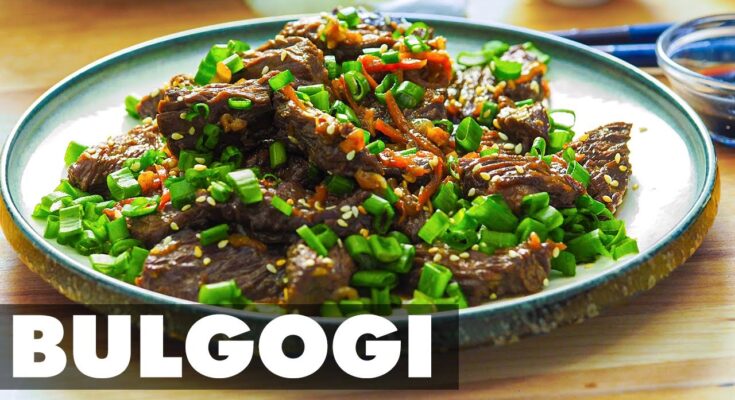Bulgogi Recipe: Bulgogi, meaning “fire meat” in Korean, is a classic dish known for its flavorful marinated meat, typically beef. The dish features thinly sliced beef marinated in a mixture of soy sauce, sesame oil, garlic, sugar, and other spices, then cooked over a grill or stovetop. Its sweet and savory profile makes it a crowd-pleaser for all occasions.
Origins of Bulgogi
Bulgogi dates back to the Goguryeo dynasty (37 BCE–668 CE) when grilling meat was a prominent part of Korean culinary traditions. Over centuries, it evolved into the dish we know today, reflecting Korea’s rich history and love for bold flavors.
Why Bulgogi Is a Global Favorite
Bulgogi’s versatility, quick cooking time, and rich taste have made it a global sensation. Its adaptability to different diets and cooking methods further cements its place in international kitchens.
Ingredients Needed for Bulgogi
Essential Ingredients
To make authentic Bulgogi, you’ll need:
- Beef (ribeye or sirloin): Thinly sliced for maximum tenderness.
- Soy sauce: The base of the marinade.
- Sesame oil: Adds a nutty aroma.
- Sugar: Balances the saltiness.
- Garlic and ginger: Key aromatics for depth.
- Green onions: For a fresh bite.
Optional Ingredients for Extra Flavor
- Asian pear: Adds sweetness and helps tenderize the meat.
- Honey or brown sugar: Alternative sweeteners.
- Chili flakes or gochujang: For a spicy kick.
Substitutions for Special Diets
- Low-sodium soy sauce for a healthier option.
- Coconut sugar instead of white sugar.
- Tofu or mushrooms as a beef substitute for vegetarians.
Tools You’ll Need
Kitchen Equipment for Bulgogi Preparation
- Sharp knife: Essential for slicing meat thinly.
- Mixing bowls: For marinating the beef.
- Tongs: For flipping meat during cooking.
- Grill or non-stick pan: Key for cooking.
Best Cooking Surfaces for Bulgogi
- Korean BBQ grill plates: Ideal for traditional cooking.
- Cast iron skillet: A great alternative for stovetop preparation.
- Electric griddles: Convenient for large batches.
Preparing the Meat
Choosing the Right Meat Cut
Ribeye or sirloin are the most common cuts for Bulgogi due to their tenderness and flavor. Look for marbled cuts as the fat enhances juiciness.
Tips for Slicing the Beef Thinly
Freeze the beef for 30–45 minutes before slicing. This firms it up, allowing you to cut wafer-thin slices easily. Always slice against the grain to ensure tenderness.
Marinating the Beef: Step by Step
- Combine soy sauce, sesame oil, sugar, garlic, ginger, and other seasonings in a bowl.
- Add thinly sliced beef to the marinade, ensuring all pieces are evenly coated.
- Cover and refrigerate for at least 1 hour, but ideally overnight for deeper flavor absorption.
Making the Marinade
Key Ingredients for Bulgogi Marinade
The marinade is the soul of Bulgogi. Essential ingredients include:
- Soy sauce
- Sesame oil
- Minced garlic
- Grated ginger
- Sugar or honey
Balancing Flavors in the Marinade
Achieving the perfect balance between salty, sweet, and umami is key. Adjust sugar and soy sauce to your taste preference.
How Long to Marinate Bulgogi for Maximum Flavor
While 1–2 hours is sufficient, marinating overnight infuses the beef with intense flavors, making the dish unforgettable.
Cooking Bulgogi – Methods and Techniques
Traditional Grill Method
Grilling Bulgogi over an open flame brings out its authentic, smoky flavor. To prepare it traditionally:
- Preheat your charcoal or gas grill.
- Place the marinated beef slices on the grill, ensuring they don’t overlap.
- Cook for about 2–3 minutes per side or until the edges caramelize.
- Keep an eye on the heat to prevent burning, as the sugar in the marinade can char quickly.
Pro tip: If you have a Korean BBQ grill plate, place it over the flame for the best results.
Cooking Bulgogi on a Stovetop
If you don’t have access to a grill, a stovetop works perfectly:
- Heat a non-stick pan or cast-iron skillet over medium-high heat.
- Add a small amount of oil to the pan.
- Cook the beef slices in batches to avoid overcrowding.
- Stir occasionally to ensure even cooking, letting the meat caramelize slightly.
This method is convenient for indoor cooking and still produces a rich, savory dish.
Alternative Cooking Options: Oven and Air Fryer
For hands-free cooking:
- Oven Method: Preheat to 375°F (190°C). Spread the marinated meat evenly on a baking sheet lined with foil. Bake for 10–12 minutes, then broil for 2 minutes for caramelized edges.
- Air Fryer Method: Arrange the beef slices in a single layer in the basket. Cook at 375°F for 8–10 minutes, flipping halfway through.
Both methods are excellent for preparing Bulgogi quickly and without constant attention.
Serving Bulgogi the Right Way
Pairing Bulgogi with Side Dishes
Bulgogi is traditionally served with a variety of Korean side dishes, known as banchan. Popular options include:
- Kimchi: Fermented cabbage with a spicy kick.
- Japchae: Stir-fried glass noodles with vegetables.
- Steamed rice: A neutral base to balance the bold flavors of the meat.
- Pickled radishes: To add a tangy contrast.
A refreshing green salad or lettuce wraps also pair well with Bulgogi.
Presentation Tips for a Restaurant-Like Experience
- Serve Bulgogi on a hot cast-iron skillet or stone plate to keep it sizzling.
- Garnish with sesame seeds and chopped green onions for a professional touch.
- Arrange side dishes and rice neatly around the main dish for an authentic Korean-style meal presentation.
Tips for Perfect Bulgogi Every Time
Common Mistakes to Avoid
- Skipping the marinade time: The longer you marinate, the better the flavor.
- Overcooking the meat: Thin slices cook quickly; avoid leaving them on the heat too long.
- Crowding the pan: Cook in small batches to ensure the meat caramelizes instead of steaming.
Enhancing Flavor with Garnishes
- Sprinkle toasted sesame seeds for extra crunch.
- Add a drizzle of sesame oil before serving for a richer taste.
- Serve with sliced chili peppers for a spicy kick.
Adjusting the Recipe to Your Taste
Experiment with the marinade ingredients to suit your preferences:
- Add more sugar for a sweeter profile.
- Include extra garlic for a robust flavor.
- Mix in chili paste or flakes for spice lovers.
Nutritional Value of Bulgogi
Calories and Macronutrients
A standard serving of Bulgogi (100 grams) contains approximately:
- Calories: 200–250
- Protein: 20–25 grams
- Fat: 10–15 grams
- Carbohydrates: 8–12 grams (depending on sugar content in the marinade).
Health Benefits of Key Ingredients
- Garlic and ginger: Boost immunity and digestion.
- Beef: A great source of iron, zinc, and high-quality protein.
- Sesame oil: Packed with healthy fats and antioxidants.
Making Bulgogi Healthier with Modifications
- Use lean cuts like sirloin or eye of round to reduce fat content.
- Substitute sugar with natural sweeteners like honey or stevia.
- Serve with quinoa or cauliflower rice for a lower-carb option.
Variations of Bulgogi
Pork Bulgogi
Swap beef for pork, particularly cuts like pork shoulder or belly. The marinade remains the same but pairs beautifully with the richer flavor of pork.
Chicken Bulgogi
For a lighter alternative, use boneless chicken thighs. They absorb the marinade well and remain juicy after cooking.
Vegetarian Bulgogi
Replace meat with mushrooms, tofu, or seitan. Portobello mushrooms are especially good at mimicking the texture and absorbing the marinade flavors.
Storage and Reheating Tips
How to Store Bulgogi Properly
- Refrigerate cooked Bulgogi in an airtight container for up to 3 days.
- For longer storage, freeze portions in zip-lock bags for up to 2 months.
Best Ways to Reheat Bulgogi Without Losing Flavor
Avoid overcooking during reheating to maintain tenderness.
Reheat on a stovetop over medium heat with a splash of water to prevent drying out.
Use a microwave on medium power, covered with a damp paper towel to retain moisture.
FAQs about Bulgogi Recipe
What is Bulgogi?
Bulgogi is a popular Korean dish made with thinly sliced beef marinated in a flavorful mixture of soy sauce, sugar, sesame oil, garlic, and other seasonings. It is typically grilled or stir-fried, resulting in a savory and slightly sweet taste.
What kind of beef is best for Bulgogi?
Tender cuts like ribeye, sirloin, or brisket are ideal for Bulgogi. The thin slicing helps the marinade penetrate the meat, enhancing its flavor and tenderness.
Can I make Bulgogi with other proteins?
Yes, you can! While beef is traditional, you can substitute it with chicken, pork, or even tofu for a vegetarian version.
How long should I marinate Bulgogi?
For best results, marinate the beef for at least 30 minutes, but overnight marination is recommended for deeper flavor.
What can I serve with Bulgogi?
Bulgogi pairs well with steamed rice, lettuce wraps, kimchi, and other Korean side dishes like pickled radish or spicy cucumber salad.
Can I cook Bulgogi without a grill?
Absolutely! You can use a stovetop skillet or a broiler to cook Bulgogi if a grill isn’t available.
Is Bulgogi spicy?
Traditional Bulgogi is not spicy, but you can add red pepper flakes or gochujang (Korean chili paste) for a spicy kick.
Can I freeze Bulgogi?
Yes, you can freeze marinated raw Bulgogi or cooked leftovers. Store it in an airtight container and freeze for up to three months.
What is the origin of Bulgogi?
Bulgogi has roots in Korean cuisine dating back to the Goguryeo era (37 BCE–668 CE), evolving over centuries to become a beloved modern dish.
Is Bulgogi gluten-free?
To make Bulgogi gluten-free, use tamari or a gluten-free soy sauce alternative in the marinade.
By addressing these common questions, you’ll master the art of making and enjoying Bulgogi, a classic dish that brings Korean flavors to your table!
Conclusion
Bulgogi is more than just a meal; it’s a celebration of flavor and tradition. With its savory-sweet marinade, tender meat, and endless serving possibilities, it’s no wonder bulgogi has earned its place as a Korean culinary icon. Whether you stick to the traditional recipe or explore creative fusions, this dish is sure to impress family and friends alike. Now, grab your apron and get ready to sizzle up some delicious bulgogi!



